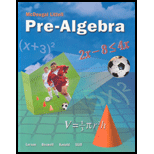
i.
To make a tree diagram to show all the different possible outcomes.
i.
Answer to Problem 16E
The tree diagram with the possible outcomes can be drawn as:
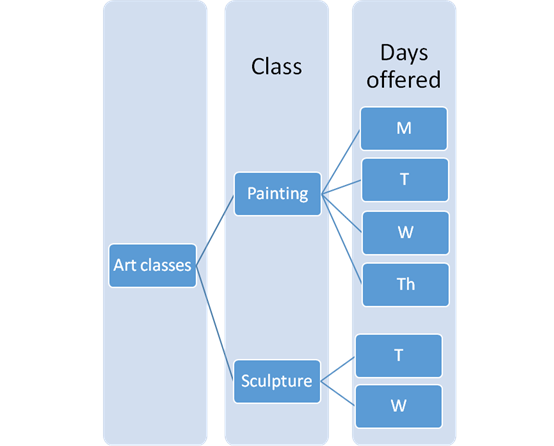
Explanation of Solution
Given:
The table provided in the question is:
| Class | Days offered |
| Painting | M, T, W, Th |
| Sculpture | T, W |
Painting class is on Monday, Tuesday, Wednesday and Thursday.
Sculpture class is on Tuesday and Wednesday.
There can be only one Painting and one Sculpture class per week.
Calculation:
The tree diagram with the possible outcomes can be drawn as:
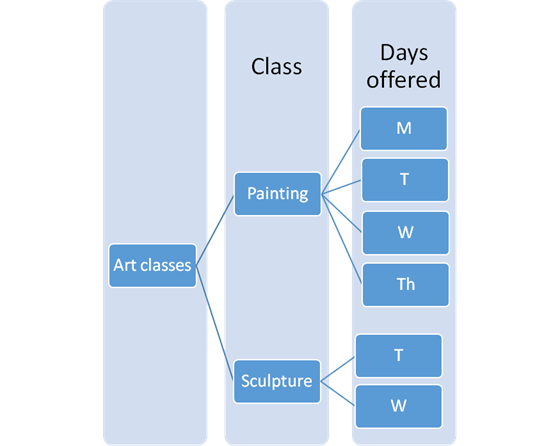
ii.
To find different possible schedules for the two classes.
ii.
Answer to Problem 16E
There are total of
Explanation of Solution
Given:
The table provided in the question is:
| Class | Days offered |
| Painting | M, T, W, Th |
| Sculpture | T, W |
Painting class is on Monday, Tuesday, Wednesday and Thursday.
Sculpture class is on Tuesday and Wednesday.
There can be only one Painting and one Sculpture class per week.
Calculation:
The tree diagram with the possible outcomes can be drawn as:
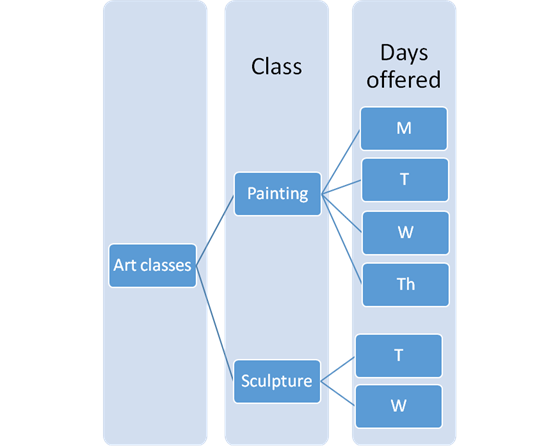
As conclude from the tree diagram there are total of
Hence,
There are total of
iii.
To find the probability.
iii.
Answer to Problem 16E
There are
Explanation of Solution
Given:
The table provided in the question is:
| Class | Days offered |
| Painting | M, T, W, Th |
| Sculpture | T, W |
Painting class is on Monday, Tuesday, Wednesday and Thursday.
Sculpture class is on Tuesday and Wednesday.
There can be only one Painting and one Sculpture class per week.
Formula used:
Calculation:
The tree diagram with the possible outcomes is shown as:
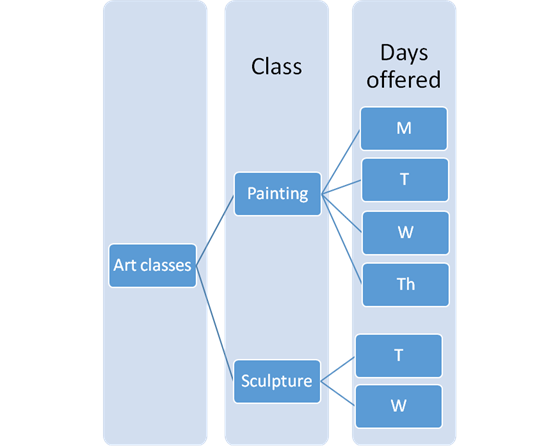
As from the tree diagram total number of outcomes is
Chances of Sculpture class schedule on Tuesday from all the outcomes is
Therefore,
Hence,
Probability of sculpture class in on Tuesday is
iv.
To explain the statement.
iv.
Answer to Problem 16E
It is better to make a tree diagram than to use the multiplication principle because a tree diagram is a simple way of representing a sequence of events and are useful in probability since they record all possible outcomes in a clear and uncomplicated manner and in a situation like this it is better to used tree diagram since it clearly shows the outcomes and eliminates the possibilities of the event occurring on the same day.
Explanation of Solution
Given:
The table provided in the question is:
| Class | Days offered |
| Painting | M, T, W, Th |
| Sculpture | T, W |
Painting class is on Monday, Tuesday, Wednesday and Thursday.
Sculpture class is on Tuesday and Wednesday.
There can be only one Painting and one Sculpture class per week.
Calculation:
It is better to make a tree diagram than to use the multiplication principle because a tree diagram is a simple way of representing a sequence of events and are useful in probability since they record all possible outcomes in a clear and uncomplicated manner and in a situation like this it is better to used tree diagram since it clearly shows the outcomes and eliminates the possibilities of the event occurring on the same day.
Chapter 6 Solutions
Pre-Algebra
Additional Math Textbook Solutions
A First Course in Probability (10th Edition)
Precalculus
Thinking Mathematically (6th Edition)
Algebra and Trigonometry (6th Edition)
Elementary Statistics
A Problem Solving Approach To Mathematics For Elementary School Teachers (13th Edition)
- . Find how many years it takes for $1786 to grow to $2063 if invested at 2.6% annual interest compounded monthly. 12+arrow_forward(1) Let M and N be non-empty subsets of a linear space X, show that whether = U or not, and show that there whether exsits a liear function from P₂(x) into R' which onto but not one-to-one or not. ام (2) Let R be a field of real numbers and P,(x)=(a+bx+cx? / a,b,ce R} be a vector space over R, show that whether there exsit two hyperspaces A and B such that AUB is a hyperspace or not. (3) Let A be an affine set in a linear space X over afield F and tEA, show that A-t is a subspace of Xand show that if M and N are balanced sets then M+N is balanced set. (4) Write the definition of bounded set in a normed space, and write with prove an equivalent statement to definition. (5) Let d be a metric on a linear space X over a field F, write conditions on d in order to get that there is a norm on X induced dy d and prove that. (6) Let M be a non-empty subset of a normed space X, show that xEcl(M) iff for any r>o there exsits yEM such that llx-yllarrow_forwardFind all solutions to the following equation. Do you get any extraneous solutions? Explain why or why not. 2 2 + x+1x-1 x21 Show all steps in your process. Be sure to state your claim, provide your evidence, and provide your reasoning before submitting.arrow_forwardDirections: For problems 1 through 3, read each question carefully and be sure to show all work. 1. What is the phase shift for y = 2sin(2x-)? 2. What is the amplitude of y = 7cos(2x+л)? 3. What is the period of y = sin(3x-π)? Directions: For problems 4 and 5, you were to compare and contrast the two functions in each problem situation. Be sure to include a discussion of similarities and differences for the periods, amplitudes, y-minimums, y-maximums, and any phase shift between the two graphs. Write in complete sentences. 4. y 3sin(2x) and y = 3cos(2x) 5. y 4sin(2x) and y = cos(3x- -플)arrow_forward2. Find the exact value of 12 + 12+12+√√12+ √12+ 12arrow_forwardTechnetium-99m is used as a radioactive tracer for certain medical tests. It has a half-life of 1 day. Consider the function TT where T(d)T(d) =100(2)−d=100(2)−d is the percent of Technetium-99m remaining dd days after the test. Which expression represents the number of days until only 5% remains?arrow_forward1. Find the inverse of f(x) = = 2x 1+2x Then find the domain of the inverse.arrow_forwardLet S = be a set of k vectors in R^, with karrow_forwarda) [1√2-31x+1√3-11y = x (1 - √2) + √34 LI√2-21x-1√3-3/4= √34 - √2x-4arrow_forwardPlease Help me answer this linear algebra question. This is a practice textbook question.arrow_forward1. a scientist observed a bacterium in a microscope. it measured about .0000029 meter in diameter which of the following is closest to it? A- 2 x 10^-6, B- 2 x 10^-5, C- 3 x 10^-5, or D- 3 x 10^-6 2.express the product of 500 and 400 in scientific notation. is it 2 x 10^5 or 2 x 10^4 or 2 x 10^3 or 20 x 10^4arrow_forwardPlease Help me answer this linear algebra question. This is a practice textbook question.arrow_forwardarrow_back_iosSEE MORE QUESTIONSarrow_forward_iosRecommended textbooks for you
 Algebra and Trigonometry (6th Edition)AlgebraISBN:9780134463216Author:Robert F. BlitzerPublisher:PEARSON
Algebra and Trigonometry (6th Edition)AlgebraISBN:9780134463216Author:Robert F. BlitzerPublisher:PEARSON Contemporary Abstract AlgebraAlgebraISBN:9781305657960Author:Joseph GallianPublisher:Cengage Learning
Contemporary Abstract AlgebraAlgebraISBN:9781305657960Author:Joseph GallianPublisher:Cengage Learning Linear Algebra: A Modern IntroductionAlgebraISBN:9781285463247Author:David PoolePublisher:Cengage Learning
Linear Algebra: A Modern IntroductionAlgebraISBN:9781285463247Author:David PoolePublisher:Cengage Learning Algebra And Trigonometry (11th Edition)AlgebraISBN:9780135163078Author:Michael SullivanPublisher:PEARSON
Algebra And Trigonometry (11th Edition)AlgebraISBN:9780135163078Author:Michael SullivanPublisher:PEARSON Introduction to Linear Algebra, Fifth EditionAlgebraISBN:9780980232776Author:Gilbert StrangPublisher:Wellesley-Cambridge Press
Introduction to Linear Algebra, Fifth EditionAlgebraISBN:9780980232776Author:Gilbert StrangPublisher:Wellesley-Cambridge Press College Algebra (Collegiate Math)AlgebraISBN:9780077836344Author:Julie Miller, Donna GerkenPublisher:McGraw-Hill Education
College Algebra (Collegiate Math)AlgebraISBN:9780077836344Author:Julie Miller, Donna GerkenPublisher:McGraw-Hill Education
 Algebra and Trigonometry (6th Edition)AlgebraISBN:9780134463216Author:Robert F. BlitzerPublisher:PEARSON
Algebra and Trigonometry (6th Edition)AlgebraISBN:9780134463216Author:Robert F. BlitzerPublisher:PEARSON Contemporary Abstract AlgebraAlgebraISBN:9781305657960Author:Joseph GallianPublisher:Cengage Learning
Contemporary Abstract AlgebraAlgebraISBN:9781305657960Author:Joseph GallianPublisher:Cengage Learning Linear Algebra: A Modern IntroductionAlgebraISBN:9781285463247Author:David PoolePublisher:Cengage Learning
Linear Algebra: A Modern IntroductionAlgebraISBN:9781285463247Author:David PoolePublisher:Cengage Learning Algebra And Trigonometry (11th Edition)AlgebraISBN:9780135163078Author:Michael SullivanPublisher:PEARSON
Algebra And Trigonometry (11th Edition)AlgebraISBN:9780135163078Author:Michael SullivanPublisher:PEARSON Introduction to Linear Algebra, Fifth EditionAlgebraISBN:9780980232776Author:Gilbert StrangPublisher:Wellesley-Cambridge Press
Introduction to Linear Algebra, Fifth EditionAlgebraISBN:9780980232776Author:Gilbert StrangPublisher:Wellesley-Cambridge Press College Algebra (Collegiate Math)AlgebraISBN:9780077836344Author:Julie Miller, Donna GerkenPublisher:McGraw-Hill Education
College Algebra (Collegiate Math)AlgebraISBN:9780077836344Author:Julie Miller, Donna GerkenPublisher:McGraw-Hill Education